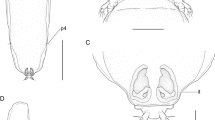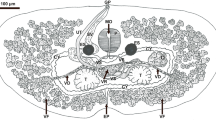Abstract
The copepod Naobranchia lizae (Kroyer, 1863) and the monogenean Metamicrocotyla macracantha (Alexander, 1954; Koratha, 1955) are gill parasites found on the striped mullet (Mugil cephalus) in the Charleston Harbor Estuarine System (South Carolina, USA). Branchial distribution of each species was studied in mono- and bispecific conditions. No preference for the right or left side of the fish host was observed for either species in either condition. Both species exhibited heterogeneous distribution among the gill arches, with a preference for arch I. N. lizae exhibited intraspecific competition and a saturation threshold in both mono- and bispecific conditions. A shift in niche toward the posterior arches was observed for M. macracantha only in bispecific infection. Interspecific competition was detected exclusively on the posterior arches, where M. macracantha seemed out-competed by N. lizae. The data indicated that both neutral and negative interactions played a role in determining the distribution of N. lizae and M. macracantha individuals on the gill arches of M. cephalus.


Similar content being viewed by others
References
Baker TG, Viricel A, Meraziz L, de Buron I (2005) Size variation of adult polyopisthocotylid Metamicrocotyla macracantha (Monogenea) in relation to host size. Comp Parasitol 72(2):179–182
Baker TG, Pante E, Roumillat WA, Lesveque EG, de Buron I (in preparation) Population dynamics of the polyopisthocotylid, Metamicrocotyla macracantha, a gill parasite of the striped mullet, Mugil cephalus in South Carolina.
Barker DE, Cone DK (2000) Occurrence of Ergasilus celestis (Copepoda) and Pseudodactylogyrus anguillae wild eels (Anguilla rostrata) in relation to stream flow, pH and temperature, and recommendations for controlling their transmission among captive eels. Aquaculture 187(3–4):261–274
Bashirullah AK (2000) Non-interactive coexistence of two parasitic copepods of Caranx hippos (Carangidae) in eastern Venezuela. Crustac Issues 12:791–796
Benz GW, Dupre KS (1987) Spatial distribution of the parasite Kroyeria carchariaeglauci Hesse, 1879 (Copepoda: Siphonostomatoida: Kroyeriidae) on gill of the blue shark (Prionace glauca) (L., 1758). Can J Zool 65(5):1275–1281
Boemare N, Givaudan A, Brehélin M, Laumond C (1997) Symbiosis and pathogenicity of nematode–bacterium complexes. Symbiosis 22:21–45
Buckmann K (1988) Spatial distribution of Pseudodactylogyrus anguillae and P. bini (Monogenea) on the gills of the European eel, Anguilla anguilla. J Fish Biol 32:801–802
Cecchini S, Saroglia M (2002) Antibody response in sea bass (Dicentrarchus labrax) in relation to water temperature and oxygenation. Aquacult Res 33(2):607–613
Conroy G, Conroy DA, Rodriguez A (1985) A note on the occurrence of “coiled” Metamicrocotyla macracantha on the gills of silver mullet (Mugil curema) from Chichiriviche, Venezuela. Bull Eur Assoc Fish Pathol 5(3):66–67
Dzika E, Szymanski S (1989) Co-occurrence and distribution of monogenean of the genus Dactylogyrus on the gill of bream, Abramis brama L. Acta Parasitol Polonica 34:1–14
El Hafidi F, Berrada-Rkhami O, Benazzou T, Gabrion C (1998) Microhabitat distribution and coexistence of Microcotylidae (Monogenea) on the gills of the striped mullet Mugil cephalus: chance of competition? Parasitol Res 84:315–320
Geets A, Coene H, Ollevier F (1997) Ectoparasites of the whitespotted rabbitfish, Siganus sutor (Valenciennes, 1835) off the Kenyan Coast: distribution within the host population and site selection on the gills. Parasitology 115:69–79
Hanek G, Fernando CH (1978) Seasonal dynamics and spatial distribution of Cleidodiscus stentor Mueller 1937 and Ergasilus centrarchidarum Wright 1882, gill parasites of Ambloplites rupestris (Raf.). Can J Zool 56(6):1244–1246
Holmes JC (1990) Helminth communities in marine fishes. In: Esch GW, Bush AO, Aho JM (eds) Parasite communities: patterns and processes. Chapman & Hall, London, pp 101–156
Hosmer DW, Lemeshaw S (2000) Applied logistic regression. Wiley, New York
Hughes GM, Morgan M (1973) The structure of fish gills in relation to their respiratory function. Biol Rev 48:419–475
Jenkins SN, Benhke JM (1977) Impairment of primary expulsion of Trichuris muris in mice concurrently infected with Nematospiroides dubius. Parasitology 75:71–78
Kabata Z (1988) Guide to the parasites of fishes of Canada. Part II: Crustacea. Can Special Pub Fish Aquat Sci 101:1–184
Koskivaara M (1992) Environmental factors affecting monogeneans parasitic on freshwater fishes. Parasitol Today 8:339–342
Koskivaara M, Valtonen ET (1992) Dactylogyrus (Monogena) communities on the gills of roach in three lakes of Central Finland. Parasitology 104:263–272
Lo CM, Morand S (2000) Spatial distribution and coexistence of monogenean gill parasites inhabiting two damselfishes from Moorea Island in French Polynesia. J Helminthol 74:329–336
Lo CM, Morand S (2001) Gill parasites of Cephalopholis argus (Teleostei: Serranidae) from Moorea (French Polynesia): site selection and coexistence. Folia Parasitol 48:30–36
Loker ES, Adema CM (1995) Schistosomes, echinostomes and snails: comparative immunobiology. Parasitol Today 11:120–124
Lyndon AR, Vidal-Martinez VM (1994) The microhabitat and morphology of Grubea cochlear on the gills of mackerel from Lyme Bay, southern England. J Mar Biol Assoc UK 74:731–734
Matejusova I, Simkova A, Sasal P, Gelnar M (2003) Microhabitat distribution of Pseudodactylogyrus anguillae and Pseudodactylogyrus bini among and within gill arches of the European eel (Anguilla anguilla L.). Parasitol Res 89:290–296
Minchew CD (1977) The occurrence of a “coiled” Metamicrocotyla macracantha on the gills of the mullet, Mugil cephalus. Proc Helminthol Soc Wash 44:106
Morand S, Simkova A, Matejusova I, Plaisance L, Verneau O, Desdevises Y (2002) Investigating patterns may reveal processes: evolutionary ecology of ectoparasitic monogeneans. Int J Parasitol 32:111–119
Nie P (2000) Microhabitat distribution of metazoan parasites on gills of Silurus asotus in Jiangkou reservoir, Jiangxi Province, China. Chin J Oceanol Limnol 18(1):54–60
Ojha J, Hughes GM (2001) Effect of branchial parasites on the efficiency of the gills of a freshwater catfish, Wallago attu. J Zool Lond 255:125–129
Paling ER (1967) A method of estimating the relative volume of water flowing over the different gills of freshwater fish. J Exp Biol 48:533–544
R Development Core Team (2003) R: A language and environment for statistical computing. R Foundation for Statistical Computing, Vienna, Austria. http://www.R-project.org
Ramasamy P, Ramalinga MK, Hanna REB, Halton DW (1985) Microhabitats of gill parasites (Monogenea and Copepoda) of teleosts (Scomberoides spp.). Int J Parasitol 15:385–397
Ream RA, Theriot JA, Somero GN (2003) Influences of thermal acclimation and acute temperature change on the motility of epithelial wound healing cells (keratocytes) of tropical, temperate and Arctic fish. J Exp Biol 206(24):4539–4551
Rohde K (1979) A critical evaluation of intrinsic and extrinsic factors responsible for niche restriction in parasites. Am Nat 114:648–671
Rohde K (1991) Intra- and interspecific interactions in low density populations in resource-rich habitats. Oikos 60:91–104
Roubal F (1999) Extent of gill pathology in the toadfish Tetractenos hamiltoni caused by Naobranchia variabilis (Copepoda: Naobranchiidae). Dis Aquat Org 35:203–211
Simkova A, Gelnar M, Sasal P (2001) Aggregation of congeneric parasites (Monogenea: Dactylogyrus) among gill microhabitats within one host species (Rutilus rutilus L.). Parasitology 123(6):599–607
Simkova A, Ondrackova M, Gelnar M, Morand S (2002) Morphology and coexistence of congeneric ectopaprasite species: reinforcement of reproductive isolation? Biol J Linn Soc 76:125–135
Sokal RR, Rohlf FJ (1981) Biometry, the principles and practice of statistics in biological research, 2nd edn. W.H. Freeman and Company, New York, 859 pp
Van Muiswinkel WB (1995) The piscine immune system: innate and acquired immunity. In: Woo PTK (ed) Fish diseases and disorders, vol. 1: protozoans and metazoans infections. CAB International, Wallingford, pp 729–750
Yao W-J (2003) Spatial distribution of monogeneans and copepoda on gills of bullhead catfish Pelteobagrus fulvidraco. Acta Hydrobiol Sin 27(6):635–638
Zimmermann M, Harrison RC, Jones AF (2001) Differential parasitism by Naobranchia occidentalis (Copepoda: Naobranchiidae) and Nectobrachia indivisa (Copepoda: Lernaeopodidae) on northern rock sole (Lepidopsetta polyxystra Orr and Matarese, 2000) and southern rock sole (L. bilineata Ayres, 1855) in Alaskan waters. Fish Bull 99:371–380
Acknowledgments
We sincerely thank William A. Roumillat and the Inshore Fisheries Division of the Marine Resources Research Institute (South Carolina Department of Natural Resources) for providing the mullet as well as the biotic and abiotic data used in this study. We also extend our thanks to Samana Schwank and John P. Davis for their help with initial dissection. Constructive comments from two anonymous reviewers were greatly appreciated. This study was supported in part by NIH grant number RR16461-01 from the BRIN Program of the National Center for Research Resources.
Author information
Authors and Affiliations
Corresponding author
Rights and permissions
About this article
Cite this article
Baker, T.G., Pante, E. & de Buron, I. Co-occurrence of Naobranchia lizae (Copepoda) and Metamicrocotyla macracantha (Monogenea), gill parasites of the striped mullet Mugil cephalus.. Parasitol Res 97, 515–520 (2005). https://doi.org/10.1007/s00436-005-1485-5
Received:
Accepted:
Published:
Issue Date:
DOI: https://doi.org/10.1007/s00436-005-1485-5




